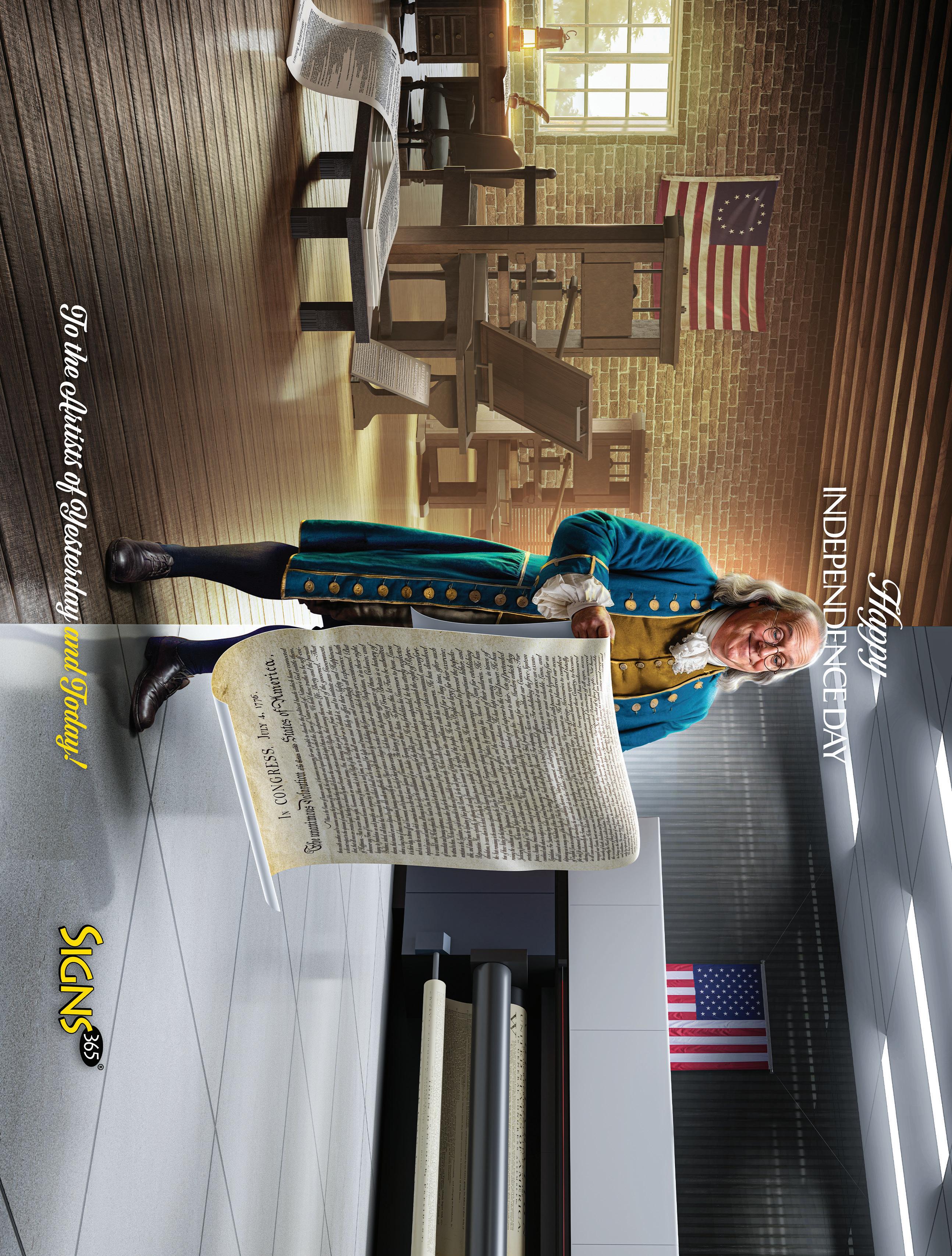










dpsmagazine.com
Volume 26, Number 4 • ISSN: 1529-2320












dpsmagazine.com
Volume 26, Number 4 • ISSN: 1529-2320

Digital print inherently adds value to all segments, from books to mail to labels and packaging. Customization, shorter turnarounds, and reduced waste are among the key benefits of the technology.
One segment that benefits from digital print and associated technologies is direct mail. As postage costs surge, print and mail
As postage costs surge, print and mail providers turn a profit and improve response by incorporating new best practices that better target and track this tried-and-true application for even stronger results.
providers turn a profit and improve response by incorporating new best practices that better target and track this tried-and-true application for even stronger results. Read more in Mastering Direct Mail.
The adoption of digital labels comes from two distinct pools of print providers—established analog label converters and commercial printers adding labels to the mix. In either event, it is essential that the workflow is properly suited for streamlined production and profitability. We discuss best practices in Digital Label Production: A Workflow Perspective.
This issue also highlights some of the newest advancements in the inkjet space that enable increased media compatibility in Engaging Customers. The article is complemented with our annual Target Chart on media options for inkjet- and toner-based production print devices.
Also in this issue you’ll find a Spotlight article focused on a successful digital flexible packaging printer.
Finally, we recap the recent Drupa 2024 trade fair, which wrapped up in June!
Best regards,

Cassandra Balentine, editor cbalentine@rockportpubs.com
EDITOR IN CHIEF
Thomas Tetreault 978-921-7850
EDITOR
Cassandra Balentine cbalentine@rockportpubs.com
ASSOCIATE EDITOR
Melissa Donovan mdonovan@rockportpubs.com
ART DIRECTOR
Sarah M. White swhite@rockportpubs.com
WEB EDITOR
Melissa Mueller
CONTRIBUTORS
Kemal Carr, Olivia Cahoon, Gina Ferrara, Mark Hanley
ADVERTISING SALES
PUBLISHER
Thomas Tetreault
64 Thissel Street #272 Prides Crossing, Massachusetts 01965 Ph 978-921-7850 x110 • Fx 978-921-7870 edit@rockportpubs.com
SALES
Amanda Doyon Ph 978-921-7850 x170 • Fx 978-921-7870 adoyon@rockportpubs.com
Subscribe online at dpsmagazine.com
CORPORATE & PUBLISHING OFFICE 64 Thissel Street #272 Prides Crossing, Massachusetts 01965
ROCKPORT CUSTOM PUBLISHING, LLC
CHAIRMAN
Jeffrey Jensen
PRESIDENT & CEO
Thomas Tetreault
CONTROLLER
Missy Tyler

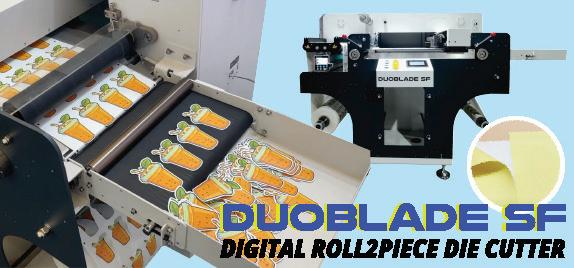

By DPS Magazine Staff
This Spring, the print industry focused its attention to Drupa, which took place from May 28 to June 7, 2024. According to the trade fair’s host, Messe Düsseldorf GmbH, the 11-day event drew 1,643 exhibitors. The international share of the visitors was 80 percent, with attendees coming from 174 countries. The organization says that after Europe, Asia was the most strongly represented region with 22 percent, followed by America with 12 percent. “Asia as well as Latin America and the Middle East and North Africa region are markets with great growth potential, which was reflected in the significant increase in exhibitors’ presence and order books,” states Messe Düsseldorf.
Here we offer some highlights from the event in the areas of inkjet, finishing, and workflow. Visit dpsmagazine.com for more event coverage.
In the digital print space, many inkjet developments were shown and introduced.
Anytron introduced its latest technological innovations, including the extended version of the ANY-JET II Plus inline digital label printer. INFO# 310
Canon U.S.A., Inc. announced an expansion of its production inkjet portfolio and entry into the B2 Sheetfed Inkjet Press market with the Canon varioPRESS iV7. The press is capable of
producing 8,700 B2 4/0 sheets per hour and printing up to 4.5 million B2 images per month. INFO# 311
DuPont launched its PN 1000 ink series, a set of low viscosity water-based pigment inkjet inks designed for commercial printing, formulated with proprietary DuPont technology, and compatible with industry standard drying technologies. INFO# 312
Gallus Group, a subsidiary of Heidelberger Druckmaschinen AG, announced its new concept, the “System to Compose,” which addresses current and evolving market needs and provides a lifeline for label printers, unlocking a host of new options across its portfolio. INFO# 313

Graph-Tech USA introduced the eZInkjet 64, a bichrome digital printing system that prints in two colors, usually black and white. INFO# 314
Heidelberger Druckmaschinen AG and Canon announced a global sales and service cooperation in inkjet printing, with a joint focus on supporting commercial print businesses striving to establish hybrid offset/digital production to meet changing print buyer needs and increase capability to handle shorter runs of more diverse jobs. Heidelberg expands its technology portfolio by introducing an inkjet
1.& 2. Drupa 2024 took place from May 28 to June 27, 2024 in Düsseldorf, Germany. Photo credit: © Messe Düsseldorf


product family based on the newly announced Canon B2 sheetfed inkjet press and the well established B3 sheetfed inkjet press. INFO# 315
Kodak unveiled a range of new solutions for digital and traditional print production. The new KODAK OPTIMAX Precoater enables efficient inline or offline application of primer to substrates for production inkjet printing. Additionally, from the portfolio of the new KODAK Finishing Solutions, developed and manufactured by Kodak, the PROSPER ULTRA 520 Press was featured inline with roll-to-roll and roll-to-fold solutions. INFO# 316
Koenig & Bauer presented its product portfolio and numerous digital innovations at drupa. The VariJET 106 digital folding carton printing press from the Koenig & Bauer Durst joint venture was presented for the first time. INFO# 317
Komori Corporation unveiled the new 29-inch sheetfed UV inkjet digital Printing press, the J-throne 29. With a printing speed of 6,000 sheets per hour for single-sided printing, the J-throne broadens Komori’s digital press portfolio, which already includes the Impremia IS29s, a
29-inch sheetfed UV inkjet digital printing system, and the Impremia NS40, a 40-inch Sheetfed Nanographic Printing System. The newly developed UV ink provides printing capability on a range of substrates such as coated and uncoated paper and paperboards without pre-treating. INFO# 318 Konica Minolta exhibited for the first time its AccurioJet 60000, a B2 high-speed UV inkjet press. The company also featured the AlphaJET, an integrated line from printing to finishing. INFO# 319
Many finishing advancements were also displayed on the show floor.
Baumer hhs showcased its Side Seam Gluing Solution, featuring the use of high-performance application heads for bottom gluing in the production of straight-line boxes as well as Xcheck DCM for monitoring product mix-ups in sheetfed die cutters using 2D codes. INFO# 320
BOBST announced its latest solutions and strategic partnerships to help shape the future of packaging and contribute to a new era in this space where the entire production line is connected. It highlighted a range of technologies including DIGITAL MASTER 55, BOBST Connect, BOBST’s Digital Front End (DFE) 3.0, BOBST ACCUCHECK, Thalia ink, MASTERCUT 165 PER, and BOBST MASTER RS 6003. INFO# 321
BW Converting, formerly BW Converting Solutions, launched an updated branding identity on the heels of incorporating leading print and industrial technology company Baldwin into its roster. INFO# 322
Duplo expanded its B2 portfolio with the launch of two major products in North America—the DuSense DDC-8000 B2 Raised Spot UV Coater and the DSM1000 B2 Platen Die Cutter. INFO# 323
EMT demonstrated its modular Chameleon finishing line, which includes unwinding, DP22 PRO dynamic perf and punch continuous-feed processor line that supports digital printing applications and press materials with high-speed performance and enhanced flexibility with up to ten processes in the same machine, and an RFX cutstack solution. INFO# 324
Hönle announced that the group’s individual companies have been consolidated into an organization with three business units—the BU Adhesive Systems, the BU Disinfection, and the BU Curing. INFO# 325
Horizon brought and showcased over 450 pieces of equipment. Its booth featured 18 systems, collaborated with more than partners, and had more than 100 direct Horizon employees at the show. INFO# 326
Kongsberg Precision Cutting Systems revealed its newest automation innovation, which boasts a significantly larger vacuum plenum plate and several new features that minimize setup and the need for manual adjustments. The upgraded Kongsberg Feeder & Stacker v1.2 helps reduce downtime and enable faster turnaround to boost throughput. INFO# 327
MGI highlighted the AlphaJET, the first Digital Printing Factory 5.0. In one pass, this solution is able to print in CMYK 1,600x1,600 dpi; apply a protective varnish; a 2D/3D spot UV varnish in fixed or variable data; and 2D/3D hot stamping foil in fixed or variable data on B1/B2 sheets. INFO# 328
Müller Martini showcased how its solutions help harness the full potential of new technologies, including the world premiere of the Starbook Sheetfolder from the Hunkeler range. The audience
experienced how digitally produced signature sheets are transformed into glued book blocks, which then move on to inline processing in the Vareo PRO perfect binder. Further, an innovative, compact smart factory solution made up of the SigmaLine Compact book block line, the Antaro Digital perfect binder, and the InfiniTrim trimming robot put out four different digitally produced products without any manual intervention. The popular workhorse, Primera PRO, presents new functions and additional optimizations for the continuous production of many small jobs with reduced staff. INFO# 329 palamides GmbH demonstrated the mitra Automatic Sheet Delivery and the Bograma BSR 550. The mitra Automatic Cut-Sheet Delivery is a versatile delivery
system for all types of cutsheet production. The mitra offers a high throughput speed and flexibility behind any production machine. INFO# 330
Scodix highlighted its new presses, the Scodix Ultra 2500 SHD and the Scodix Ultra 650 SHD, 16 embellishment applications, and Scodix AI. INFO# 331
Workflow tools help bring all technologies together for more efficiency and effectiveness across the industry.
DALIM SOFTWARE unveils the nextgeneration of its DALIM ES and DALIM TWIST applications, which are completely redeveloped from the ground up on a scalable microservice architecture and featuring a redesigned user interface. INFO# 332
Enfocus exhibited its full range of PDF preflight and workflow solutions at drupa. Visitors were able to see firsthand the benefits of Enfocus solutions such as Griffin, Phoenix2Switch, PitStop Pro, and Switch. INFO# 333
Esko hosted a number of partner integration demonstrations, including MIS software integration with CERM and LabelTraxx; web front-end integration with Infigo and Packitoo HIPE; and flexographic plate management with The Grey Elephant. The Esko booth also featured a Rhyguan rewinder as part of a demonstration of Esko’s AVT inspection solutions. Other partner booths on which Esko showed how its solutions easily integrate with other platforms included Asahi Kasei, Barberan, Bobst, DuPont, ePS, Fiery, GIS, GlobalVision, HP, Heidelberg,
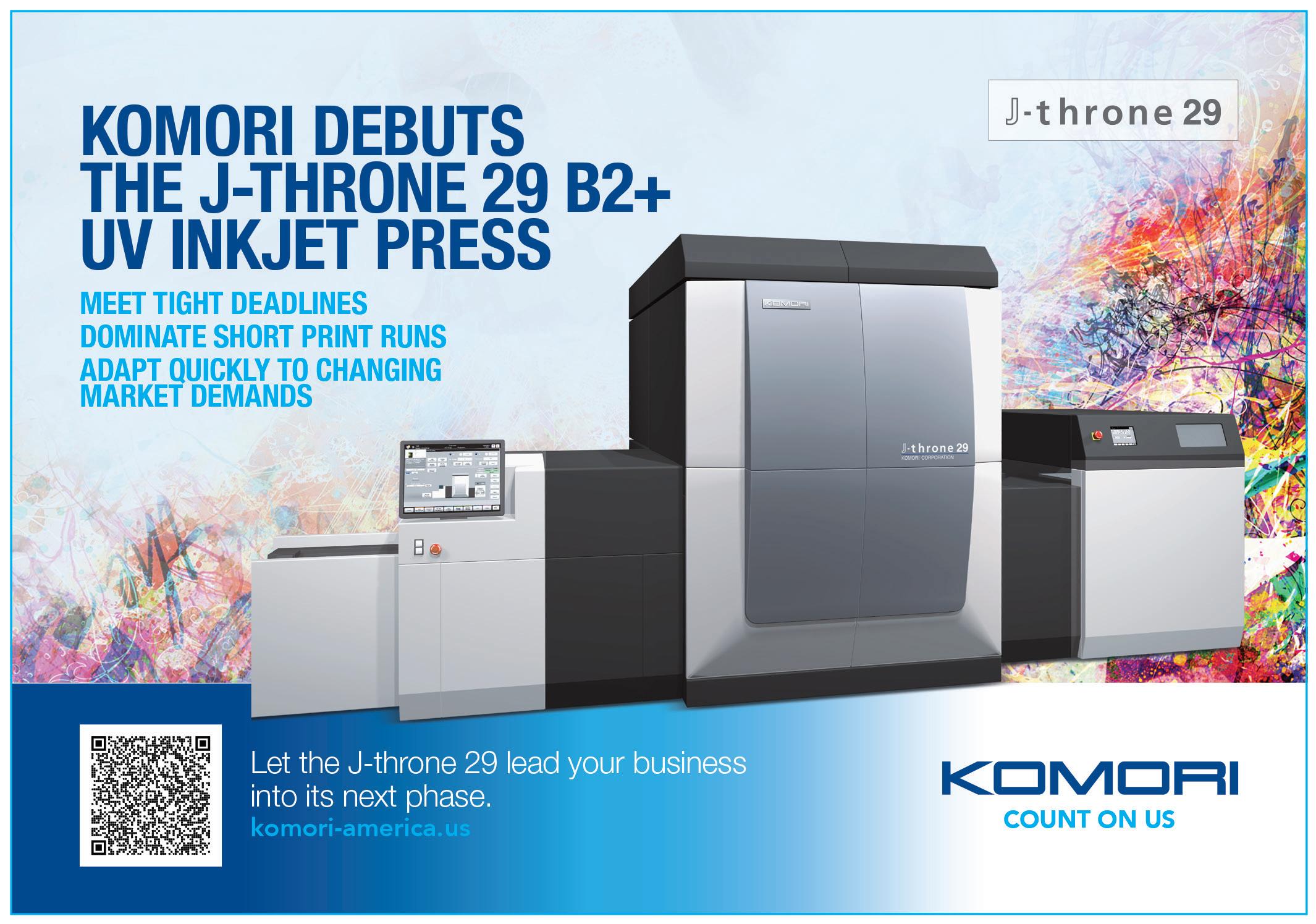
Highcon, Kongsberg Precision Cutting Systems, Landa, and Windmoeller & Hoelscher. INFO# 334
Fiery, LLC announced that its DFE technology is driving the X5 Nozomi from Packsize. The Fiery technology is designed to provide X5 Nozomi customers with unparalleled digital print performance, superior color management, and automated workflow tools. INFO# 335
Gelato announced a partnership with Landa Digital Printing. The collaboration leverages Landa’s Nanographic print technology and customer network, and Gelato’s global software platform—GelatoConnect—for the delivery of on-demand, short-to-medium run, digitally printed jobs with print quality. Utilizing Gelato’s fulfillment network, present in more than 32 countries, digital print partners also benefit from streamlined workflows,
enhanced market reach, and a shared commitment from both companies toward enhanced sustainability. INFO# 336
GMG Color Americas showcased ColorFarm, which is well suited for easy job quoting and production control. The GMG Color Americas team also shared a new update in the form of GMG ColorPlugin for Adobe Illustrator, a vector conversion sibling tool to GMG ColorPlugin for Adobe Photoshop. INFO# 337
HP and Canva announced a strategic, multi-year global partnership. INFO# 338
ICScolor, creator of Remote Director, demonstrated how virtual digital color proofing is a future trend utilizing calibrated monitors versus inkjet paper proofs. INFO# 339
TECHKON showcased its Inline Spectrophotometer technology, including the SpectroVision inline color
measurement system for packaging printers and the SpectroEdge ES7500 customizable integration kit for press manufacturers. INFO# 340
In partner booths, EMT and Kodak, Videk featured its Digital Eyes solutions, designed to replace manual, time-consuming human inspection processes with powerful, productivity-driving automation. INFO# 341
X-Rite showed its PantoneLIVE Private Library Manager, a feature that allows brands to add custom colors to the PantoneLIVE ecosystem. INFO# 342
After eight long years, the industry was more than ready for another Drupa. There is no doubt vendors will continue innovating on through to the next show planned for 2028. dps

By Melissa Donovan 0--
Many companies in the flexible packaging industry have heralded digital printing, whether it be adding a printer to their existing business or creating a spin-off of their organization entirely, one withjust a digital focus.
Each scenario recognizes digital printing's on-demand, sustainable production capabilitiesfor flexiblepackaging.
Galloway Consolidated Holdingsknown as a leader in the flexible packaging industry-is comprised of three sister companies-Berna Incorporated, Elite Extrusion Technology, and Berna Digital Innovations (BDI).
Berna Incorporated, founded in 1959, is equipped with high-speed flexographic presses capable of ten and eight colors, pouch and bag making machines, solvent-
Its sister company Elite Extrusion Technologymanufactures polyethylene films for the flexible packaging industry. Made up of a group of experts in the field of co-extruded films, the organization operates threeWindmoeller & Hoelscher Optimex blown film lines.
With a rich history in printing and converting, Berna Incorporated keeps pace with technology advancements. In July
Brand managers are craving a way to not only capture attention but capture
a customer's long-term commitment to the brand.
- Stacey Vassil, marketing manager, BDIAdvantage Direct

2023, recognizing the benefits of digital printing in the flexible packaging space, the companycreatedBDI.
Based in St. Charles, IL, the business works out of a 20,000 square foot space with ten staffmembers. Services include digital prepress, digital printing, digital print campaign support, and digitally printed flexible packaging-roll stock films, pouches, and bags.
According to Stacey Vassil, marketing manager, BDI, Berna Incorporated chose to create a separate digital printing company to strengthen its integrated printing andconverting capabilities. less lamination, and slitters. Its technical center looks to improve quality and customer response time by incorporating digital prepress and platemaking from start to finish.
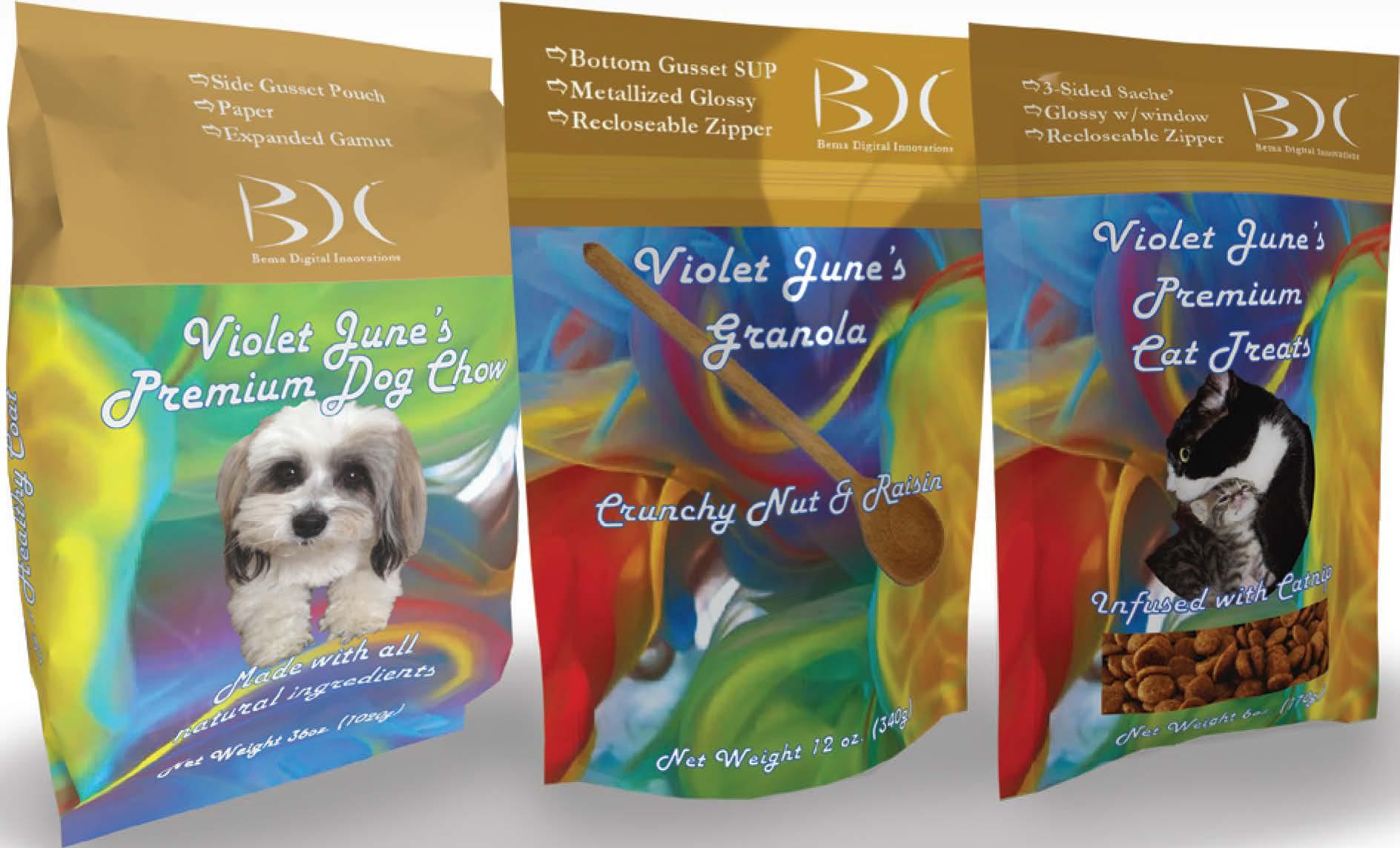
1.& 2. BDI offers digitally printed flexible packaging-roll stock films, pouches, and bags. The organization recently added twoHPIndigo25Kpressestoitsportfolio. Seen here, Glen Galloway, president, GallowayConsolidatedHoldings.

“Digital printing enables us to expand our print offerings past the unbeatable print quality we already offer. Yes, the print quality from digital printing is excellent. However, we want to offer our customers the opportunity to take digital print to the
next level by using it to build brand loyalty and turn a standard pouch into a revenue generating asset,” explains Vassil.
How is this possible? Well for BDI the focus is on customizing promotional packaging. “Packaging can be tailored to fit
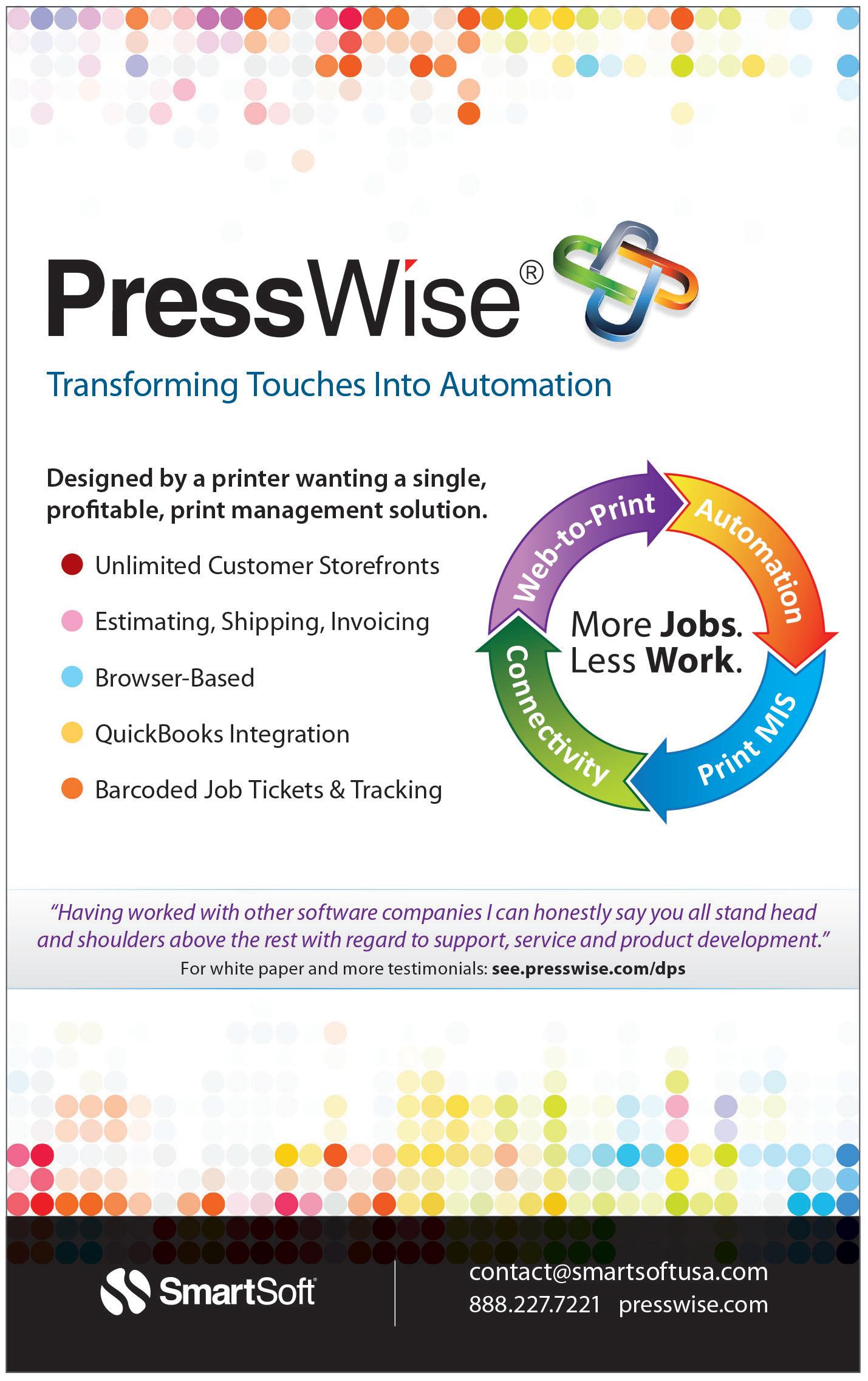
the theme of a sporting event, a concert, or a political rally. Businesses can ship online orders, offer exclusives in their physical store, and retain loyal customers with packages that deliver brand recognition. Add a name, a photo, a coupon, or a special quick response code, all without compromise to the brand’s identity,” according to a press release published by BDI in February 2024.
Signaling a true commitment to digital printing it recently added two HP Indigo 25K presses to its portfolio. The HP Indigo 25K press, with its 30-inch format, reaches speeds of 101 feet per minute (fpm) in four-color mode and 82 fpm in five-color mode. Using HP Indigo ElectroInks, this press yields a wide expanded gamut. It is available in standard CMYK, with the option to add orange, violet, green, or white.
When deciding which digital press to acquire, BDI considered not only print quality, but the integrated software tools as well. “Of all the current digital print platforms built for flexible packaging; to date, the HP Indigo 25K offers the most complete set of tools. In addition to the print quality being excellent, HP offers a superior set of software tools that our expert digital prepress team use to leverage every advantage the platform can yield, i.e, personalization, customization, serializing, as well as seasonal and targeted campaigning,” shares Vassil.
With the help of its two HP Indigo 25K presses, BDI is well on its way to achieving its goal of capitalizing on the appeal of customizable promotional packaging. Vassil says the company recently held a series of customer seminars that provided positive feedback about their intent.
“Brand managers are craving a way to not only capture attention but capture a customer’s long-term commitment to the brand,” continues Vassil. dps
By Cassandra Balentine 0--
We've been watching and covering the continued adoption of digital production processes in the label industry. While it still represents a small portion overall, this is growing. From a prepress perspective, this makes a difference in the workflow.
When a print provider gets involved in digital printing, it typically means the company is dealing with additional-or new-customer SKUs, translating to more touches by the prepress department. "With shorter run lengths more jobs are required to maintain the same volume. The best way for an organization to be more profitable is to scale the workflow-not labor-to meet those demands," offers Mike Agness, EVP, Americas, HYBRID Software.
Mike Robinson, senior product manager, Fiery, agrees, noting that
pieces that help increase response rates. Plus, the faster turnaround enables label providers to reduce the amount of setup and preparation."
Given that digital printing enables the entire production process to move faster, Robinson feels that it's important to evaluate how quickly a workflow can adapt to change. How fast can a proof be produced for a customer? And, if that customer requires a change, do you need to go back to a designer to make corrections? Or is it possible to make
The best way for an organization to be more profitable is to scale the workfiow-
not labor-to meet those demands.
file adjustments on the fly within existing prepress software or make changes right at the digital front end (DFE) on the RIPped file?
When a label printer gets involved in digital print, it is a good time to evaluate current processes and determine where there are opportunities for improvement. For example, are there manual processes, such as preflight, layout, or job approvals, that can be automated?
"It's all about the number of labels per hour at the back of the press. Moving into digital offers the opportunity to indigital printing opens up a world of capabilities for label providers. "They can respond more quickly to customer needs with one-off prototypes or versioned
- Mike Agness, EVP, Americas, HYBRID Software.

creasethe numberof jobs per day and automation plays a big part in making the most of this potential," sharesEmma Barry, product marketing manager, Domino. pieces, print exactly the amount of pieces needed, and, most importantly, develop personalized

1. & 2. HYBRID PACKZ is a complete PDF editorfor labelsandpackaging, makinglabelartworkprint-readyforanydigitalpress.

The adoption of digital comes from two distinct pools of label providers—established analog converters and commercial printers adding labels to the mix.
When considering the demands of prepress workflow when adding digital capabilities from the former, Agness suggests one of the first requirements is making sure you can touch more jobs per day so the prepress and CSR teams are able to handle greater volumes.
To achieve a rapid return on investment, prioritizing short-run, high-margin jobs is often the most effective strategy. “This necessitates a prepress process capable of higher throughput to manage a growing number of orders, often without minimum quantity constraints, encompassing multiple SKUs, and potentially variable or personalized data. The key challenge lies in identifying a workflow solution that delivers the optimal balance between automation and the cost of investment,” comments Ben Richardson, senior DFE specialist, Mark Andy.
Apart from automating as much as possible, Agness feels that it is still important to think about flexographic or offset printing. “If a job is starting on a digital press, the aspiration is that product sales quantities will grow. The expectations for the future would be to run the larger jobs on a flexographic press.”
Robinson suggests that converters moving to digital should consider their pricing model and focus on a value-based pricing of the digital output instead of a production-cost-plus margin common in price sensitive analog labels. “Analog production costs are disproportionately made up of setup time for a press, while digital production costs
are more concerned with run time on the press. The different values enabled by digital production—including short-run lengths, quick turnaround, and personalization—are monetized by label converters while the market is getting used to the possibilities of digital,” he shares.
Color challenges are paramount. “As close as digital can be, there will always be the realization that an extended gamut cannot reach everything; for example, fluorescent colors. How will a printer and designer meet these challenges?” asks Agness.
For commercial printers expanding offerings into labels and maybe packaging, different considerations center around the application itself, as well as prepress.
“Also, understand that with labels you supply a portion of the packaging and someone else is producing the end product. A label without the juice inside a bottle is not much, standalone. The label is only a component of a product. It is part of the cost of goods sold; not part of a marketing budget,” stresses Agness.
Labels often fit into irregular shapes, so it is important to be prepared for prepress challenges and cutting these shapes after the job is printed, most likely on a digital cutter. “Even substrates and adhesion can vary greatly—and that’s just when considering paper substrates. Also, printers are outputting labels in rolls; not sheets. This is far different than working on a brochure, for example, as a commercial printer,” shares Agness.
“Commercial digital providers understand the advantages of digital production and need to understand the particular needs of the label and packaging
markets,” offers Robinson. “Brand color fidelity is more important for labels than in commercial print. Incorporating color process control into the workflow is necessary to meet the strict brand/color requirements demanded in packaging.”
Commercial printers venturing into the labels and packaging (L&P) sector must be prepared to meet exacting color demands. “Achieving precision in color reproduction to align with industry standards and the ability to accurately simulate spot colors are non-negotiable requirements,” shares Richardson.
In a marketplace where the consistency of brand colors is non-negotiable— where the hue of the outer packaging must precisely match the label affixed to the product, especially when displayed side-by-side on retail shelves—maintaining strict delta E tolerances and uniformity across various presses and locations is critical, according to Richardson.
“For both commercial and established industrial printers to thrive in the L&P industry, it’s imperative to consider dedicated L&P software solutions designed to meet these stringent color fidelity demands. This calls for specialized software solutions underpinned by deep domain in-house expertise,” offers Richardson. “It’s not just beneficial but essential for meeting the high expectations of brand owners and retailers.”
Color management is a tough task for label production. “Coping with matching brand inks with a fixed set of inks gets more complicated when working with variables such as two different digital technologies and varying substrates,” shares Agness.
Robinson agrees, noting that color control is critical for brand owners to present a cohesive brand identity across all printed materials. “Ensuring the accuracy of their brand colors is the biggest part of that. Label providers need color management tools that can help
ensure consistent brand color reproduction across different printing technologies and substrates.”
It’s important for printers to have tools that enable easy adjustment of spot colors to match brand owners’ expectations. “For example, before printing a page, is it possible to view the delta E of a specific brand color to make sure it’s reproducing to the brand owners’ requirements? If it’s not, does the label provider have the tools to adjust the color details accordingly? If files are received with incorrectly named spot colors, do the color management tools quickly reassign them to the correct spot color without having to go back to a designer? Is there access to a report of how well spot colors are reproducing over time so that the label provider can always be confident that customer brand colors are reproduced to the best of a press’ ability?” asks Robinson.
One advantage of digital equipment is the ability to reproduce spot colors— such as Pantone—out of a standardized ink set. “Mark Andy offers digital printing solutions with a range of gamuts provided by four-color process and extended gamut ink sets—orange, violet, and green. Understanding how these colors are calculated and refined within the color management workflow, allows users to make any adjustments very quickly, without having to wait for a new set of plates to be processed,” offers Richardson.
Predicting the accuracy of spot color simulation and having the flexibility to adjust the target color space enables converters to achieve seamless device interchangeability between their existing machinery and the new digital press. “By establishing a robust color management process, the decision on how a print order progresses through production can often
be determined by considering the run length versus setup time. This approach empowers converters to accept orders of any size, enhancing their operational versatility,” adds Richardson.
Richardson points out that while not absolutely critical, a good in-house understanding of these processes and investment into good color software will help leverage these advantages and ensure a faster production ramp up of future machine purchases.
The future of label production is sure to be comprised of digital. Whether you are a commercial printer looking to add a new application, or a traditional label provider that wants to expand capacities, it is important to consider prepress workflow when adding digital label production capabilities. dps


By Melissa Donovan
Do less with more—it’s a current trend. So it makes sense that some of the newest introductions in the inkjet space are presses with increased media compatibility. With the ability to print to a broader range of substrates, print providers offer clients increased variety.
Expanded media compatibility is important because it enables inkjet presses and imprinting solutions to produce a wider variety of applications. “Printers can therefore compete for more jobs, become a more valuable partner for their customers, and achieve a faster return on their inkjet investment,” asserts Andrea Connor, WW solutions marketing manager, Kodak.
Increased Capabilities
Technology advancements in production inkjet result in increased media compatibility.
Inline or offline coating of print substrates is a primary component. “Increased media compatibility is achieved with specifically formulated primers. In the case of absorbent substrates, the
primer keeps the ink—specifically the color pigments—on the surface while the carrier fluid soaks into the substrate. On non-absorbent substrates, the primer creates an adhesive surface that holds the ink drops in place and prevents them from spreading or coalescing,” explains Connor.
Kodak OPTIMAX Primers, for example, can be applied inline to the substrate in a precoater. Kodak offers an OPTIMAX Enhanced Primer for coated
papers and an OPTIMAX Standard Primer for uncoated papers. OPTIMAX Packaging Primers are available for uncoated and coated corrugated and folding carton packaging applications, and personal care products, as well as for non-absorbent substrates such as plastic and film.
Increased media compatibility is achieved with specifically formulated primers
— Andrea Connor, WW solutions marketing manager, Kodak

“By applying these water-based primers, printers can avoid using inkjet-treated papers and other specialty substrates and expand their range of substrates as required. In addition to creating a thin adhesive layer so that the substrate accepts the ink, OPTIMAX Primers immobilize the pigment, allowing high-speed printing with high ink coverage.
1. & 2. Kodak OPTIMAX Primers help print providers increase media compatibility with inkjet.

OPTIMAX Primers improve ink adhesion, rub resistance, and image quality across a variety of substrates, including paper, cardboard, plastic, film, and even metalized materials,” shares Connor.
Media testing is another way to ensure and expand media compatibility. “Our inkjet products include tools and defined test suites that are used by our media lab team to evaluate new media as requested by our customers. After evaluation, we provide our customers with media profiles that can be loaded onto their press enabling automatic adjustment to optimal settings when utilizing the specified media,” says Lucy Perez-Sierra, manager, category marketing, Canon Solutions America, Inc.
Media versatility is also expanded via new technology introductions. For example, Landa Nanographic Printing presses do not place wet ink directly onto the substrate. Nanography technology “ejects Nanoink onto a heated blanket, and the result is an ultra-thin, dry polymeric film. The dry film is fully transferred to the printing substrate, thereby avoiding the ink and paper interaction inherent in digital inkjet printing,” explains Amir Shalev, market development director, Landa Digital Printing. “The options are tremendous for printing a range of papers, coated and uncoated, virgin or recycled—all without any pretreatment,” continues Shalev.
Perez-Sierra says the primary advantage when it comes to Canon’s media support is the variety of media options available to serve the diverse needs of its customers. “Our production inkjet portfolio includes products that can utilize media originally designed for alternative technologies, such as offset coated stock, along with media optimized specifically
for inkjet. This flexibility in media type positions production inkjet technology as a highly advantageous solution to many commercial printers.”
Inline or offline, applying primer that helps the substrate accept ink must work with the whole process to achieve ideal results.
Connor says that at KODAK, the water-based inks used in its KODAK Stream Inkjet Technology and KODAK ULTRASTREAM Inkjet Technologies “play a key role in this context.”
KODACHROME Inks are designed for KODAK ULTRASTREAM Inkjet Technology, which powers the KODAK PROSPER ULTRA 520 Press. KODAK EKTACOLOR Inks used in Stream Inkjet Technology, including the KODAK PROSPER 7000 Turbo Press, PROSPER 6000 Press, and PROSPER Imprinting Systems, are formulated to create brighter prints. A common feature of KODACHROME and EKTACOLOR Inks is a lower level of humectants compared to competitive inks. This results in fast drying, even when printing with high ink coverage on difficult media. The inks, together with custom-engineered near-infrared drying on PROSPER Presses, enable printing heavy ink coverage on coated and glossy papers even at high speeds.
In the case of Nanography, however, where the printing does not require any inline pretreatment to achieve fine, rich, and durable print, the ink excels in other ways. “What the NanoInk does do is stick to the substrate—any substrate. Today, any porous or non-porous off-the-shelf paper, and in the future, potentially substrates for corrugated, labels, metal, textiles, and more,” says Shalev.
To keep up with the multiple media-type introductions, print engine manufacturers partner with media suppliers.
Canon has strong partnerships with many media providers in North America. “We work with our partners to evaluate new media options as they become available so that we can support our mutual customer base and help them adapt to the latest media offerings in the market,” says Perez-Sierra.
Kodak works with all leading paper manufacturers and media suppliers to be able to recommend a wide range of substrates for PROSPER Printing Solutions to its customers. It is noteworthy that the PROSPER Presses support numerous standard offset papers. This enables printers to produce jobs on customers’ preferred papers using the most suitable printing process—inkjet or offset—depending on run length, size of the job, and other parameters.
Landa’s technology is paper agnostic, according to Shalev, “therefore we do not require partnerships to develop specialized papers to fit any limitations. We have great connections with media manufacturers, and are happy to run projects that showcase the environmental benefits of our technology.”
Media versatility is important as print providers look for ways to leverage existing technology.
“Sustainability mandates, rising paper costs, and inconsistent supply are three of the leading reasons why media compatibility has become an increasingly critical consideration for press manufacturers and their customers. Everyone wants options so paper availability is not an issue when jobs are ready to print,” admits Shalev.
To keep customers engaged it’s important to work with presses that are compatible with a wide and growing range of substrates. dps
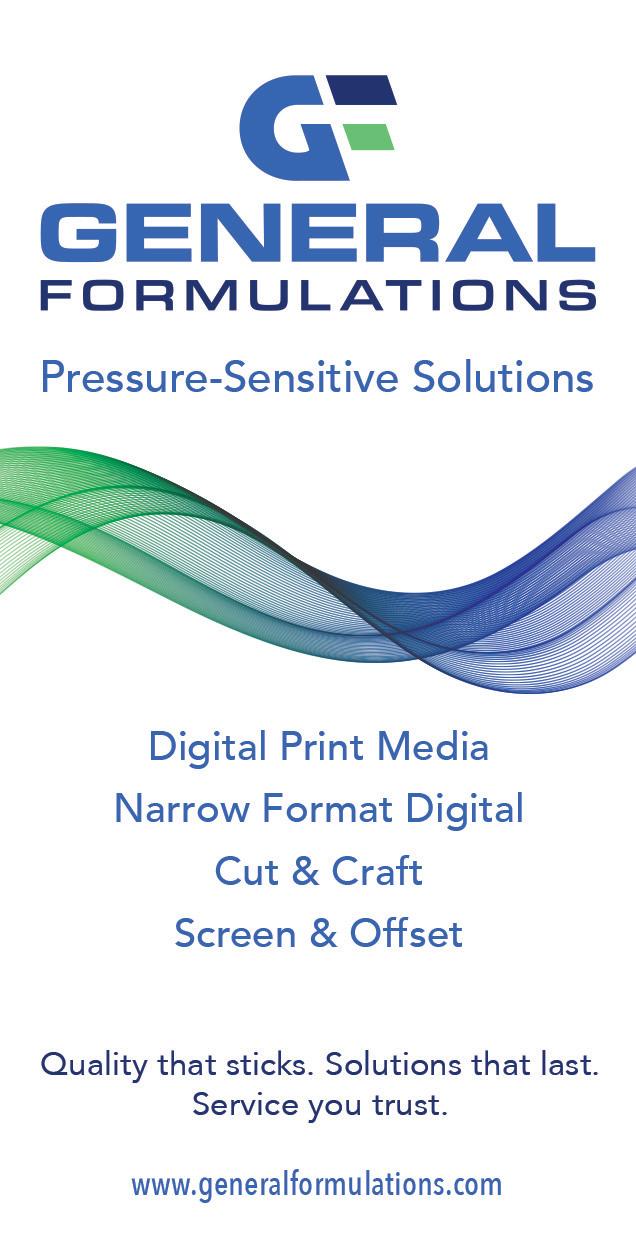


By Cassandra Balentine
With all of today's innovations in communications, tried-and-true methods sometimes make the most impact, especially when reimagined.
Direct mail has its challenges, including cost. However, by embracing new technologies, marketers are able to lower volumes and focus on targeted audiences with high-value pieces that make an impact.
"With the oversaturation and reliance of digital, combined with screen and marketing fatigue, there is a real opportunity in the nearly empty mailbox," points out Brad Kugler, CEO/ co-founder, DirectMail2.0.
Lisa Weese, senior director, marketing, Canon Solutions America, production print solutions, sees several trends in the mail space, including an increase in postcards-especially oversized; more frequent use of quick response (QR) codes in marketing mail; higher demand for recycled or FSC-certified papers;
Shown: Xerox lridesse Production Press, Xerox Versant Presses, and Xerox Primelink digital printers produce specialty colors-beyond four-color printing-to create embellishments and provide an opportunity for value-added production techniques.




data and advanced mail tracking solutions, marketers can send email and SMS text messages while the mailpiece is en route to the end recipient.
Since a typical mailpiece’s Intelligent Mail barcode is scanned on average seven times from its USPS induction point to final destination, Lien explains that a series of progressive messages can be sent to build anticipation of arrival. “It’s also worth noting that over 60 million addresses have at least one person subscribed to the USPS Informed Delivery program, which sends a daily email of what is arriving in their mailbox. This effectively means that every mail service provider has the potential of offering some type of multi-channel marketing campaign.”
There are other ways to integrate technologies for maximum impact, including variable data inkjet printing, automation in mail production and sorting, to digital marketing integration, tracking information, like QR, SMS, and other identifiers as well as hypertargeting, segmenting, and direct mail retargeting. “Today, if someone isn’t doing a few, if not all of these items, they are a dinosaur on the eve of extinction in direct mail,” cautions Kugler.
1. The new Quadient Mach 9DS inkjet system is capable of full color, fully dynamic, secure, and personalized output. 2. The Hunkeler/Horizon Roll-toDirect Mail solution goes from white paper roll or pre-printed web to finished product in a single pass, producing complex, variable data folded pieces at 600 feet per minute.
Billy Stojanovski, global production portfolio marketing manager, Xerox, also notes an increase in personalization and relevance, which is driven by client data and triggering events like an abandoned product in a cart or a request for more information to drive an action. “Direct mail pieces now often include value-added elements such as linking the printed piece to a digital or omni-channel campaign with data reporting. In addition, print service providers are using embellishments beyond simple four-color output and specialty finishing such as custom sizes, embellished envelopes, and additional stand out elements to capture attention.”
Finishing solutions like MBO America's FC23/30 allow inline additions of various coatings including gloss, matte, satin, soft touch, and more to inkjet webs.
Unlike first class mail, Scott Eganhouse, VP, business development, TEC Mailing Solutions LLC, says marketing mail is enjoying a bit of a resurgence and expects it to grow this year with the election season. “If there’s a trend it would be smaller mailings that are more targeted in nature; many of them trigger based on an event. This can be a single piece because a prospect behaved in a certain way or an event like a hailstorm that requires geographic targeting as an example.”
Eganhouse stresses that each of these use cases demand expediency and speed to the mailbox, which requires automation, fewer touch points, and
a 24-hour turnaround. “What’s more, these trigger-based mailers fundamentally change the traditional direct mail model that often leverages a saturation strategy, which controlled postal spend as a byproduct. While the per-piece spend may be higher, trigger-based mailings are often far easier to apply an attribution model making it far easier for marketers to gauge the return on investment (ROI).”
By now, personalization, QR codes, pURLs, and data analytics should no longer be seen as a trend but part of the legacy fabric that’s enhanced the viability of direct mail. “Having said that, personalization continues to evolve into new realms such as olfactory, scent being a powerful analog to one’s experiences and memories,” says Eganhouse.
The upcoming election cycle will be a great example of artificial intelligence (AI) being leveraged in a meaningful way to engage with electorate with highly targeted copy. “It’s an exciting time to see how AI will alter the marketing landscape and direct mail specifically, the election use case is here today and will provide ideation for years to come on the best way to leverage AI,” comments Eganhouse.
Trends in direct mail reflect shifting customer habits. “Direct mail businesses are increasingly focused on enhancing the value of printed materials by prioritizing shorter runs of highly customized and targeted pieces. Recent data shows that more premium, high-end direct mail marketing materials are more effective than generic mail,” says Fred Morrone, senior manager, product marketing, Kyocera.
From an equipment market perspective, William Longua, senior director, Digital Print Group, Quadient, points out that the breakdown of color printing equipment versus monochrome printing equipment purchased skews higher toward digital inkjet color printers.
“This trend has continued into 2024 and, as we provide faster and more

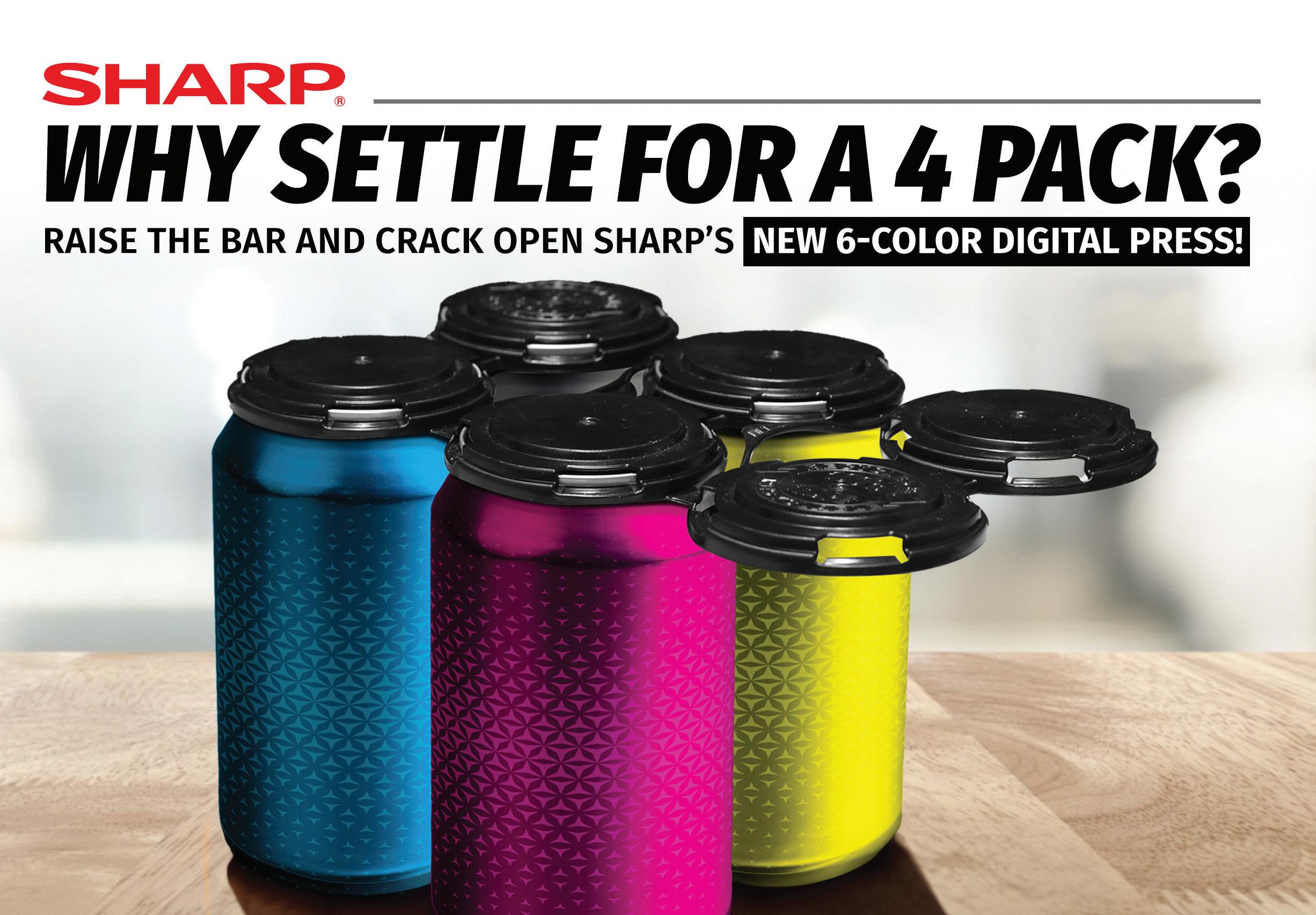
Print providers turn to inkjet for a myriad of applications, including on demand envelope printing. Envelope printing equipment manufacturer, Printware, shares the success story of a Midwestern print shop looking to deliver higher speed, quality, and profitability with its digitally printed envelopes.
The shop tried a variety of solutions, including laser and toner devices that lacked the productivity needed. Some of the inkjet devices it tried used dye-based ink, which resulted in a higher risk of smearing, which meant more dry time and higher production costs.
These issues prevented the shop from producing short-run envelope printing. They turned to Printware and soon integrated HP FI-1000 PageWide thermal inkjet technology into the iJetColor 1175 Pro printer to increase speed and profitability on full-color envelope production. The solution included bar-in-box, service station, and HP pigment inks.
With this solution, the shop experienced faster print speed with outstanding print quality, and variable costs down 70 percent, meaning the HP FI-1000-powered iJetColor 1175 Pro delivered a return on investment in just a few months.
Paper Mills, Inc., sees a significant trend in direct mail today for personalized, data-driven communication that’s produced on high-quality, sustainable substrates. “Brands use digital printing technology to create personalized mailers that stand out.”
Brannen adds that this personalization is complemented by eco-friendly substrates, which allow brands to deliver impactful, tactile, and environmentally responsible direct mail that resonates with
their target audience while supporting the sustainability values of their brand.
“The need to stand out in direct mail had meant that on top of the personalized messaging, advertisers need to stand out in design, look and feel, material, and color,” comments Amir Shalev, market development director, Landa Digital Printing. “This is leading to a push for print quality, color, and expanded paper and board usage for direct mail applications. As personalized volumes grow, a gap is created
between the static ability of offset presses and the relatively low volumes out of smaller inkjet machines.”
Some areas of direct mail show great promise, other aspects are downtrending.
“What isn’t working is doing the direct mail routing of ten years ago,” says Kugler. This includes just ink on paper with no other technology bundled up with it; using a spray-and-pray method; failing to test, test, and test again—audiences, creative, the message, and the imagery that converts; and thinking that because a message or angle worked once, it will work forever. “Marketing fatigue is real. Watch the results and the numbers,” shares Kugler.
Stojanovski feels that static, non-personalized direct mail lacking any follow-up or reporting capability is on the decline. “The ‘spray and pray’ approach does not deliver the results clients are looking for,” he asserts.
Hunt continues to see a decline in the number of direct mail providers using cutsheet monochrome production printers and continuous-feed toner printers. “Roll-fed inkjet and the latest generation of color cutsheet presses are more efficient, better meet the quality and productivity demands of the market, and more cost effective at scale. These new presses also integrate more easily with the digital infrastructure required to create value-added, variable data direct mail pieces,” he states.
Aligned with the trends in the sector, Morrone feels that the traditional approach of large-scale mailings, without personalization, is declining. “These larger runs of unqualified mailings for marketing purposes have proven to be less effective in communicating with customers. Therefore, it is no surprise we are seeing such a decline.”
In general, direct mail volumes have continued to drop. “In addition, generic, mass-mailed campaigns that lack
personalized content are declining because recipients now expect direct mail to address their unique interests. Brands relying on generic and unsustainable materials are finding it difficult to capture attention and maintain brand loyalty. In contrast, digital printing and sustainable substrates empower marketers to tailor each mailer to the individual, fostering stronger engagement and delivering more meaningful, eco-friendly message,” comments Brannen.
Johnson admits that mass-mail campaigns have shown the biggest decline. “We know that direct mail has a higher response rate versus digital-only campaigns, but the ever-increasing postage costs force marketers to carefully evaluate ROI. Mass-mail that isn’t well targeted doesn’t perform as well as highly personalized and targeted mail. Given the relatively small increase in cost to personalize, with a significantly higher response rate, it makes sense to move towards higher performing campaigns.”
Weese adds that while the decline in traditional statement printing is slowing, it’s still declining. “By comparison, marketing mail is trending upwards. Catalogs have also picked back up after years of decline,” she notes.
Sustainability and cost concerns led advertisers to examine closely the printing methods, as well as being selective in printing and measuring their ROI constantly, comments Shalev.
While the opportunity of multi-channel marketing is real and more accessible than ever, overall market spend for direct mail is declining. “The latest USPS Household Diary Study reflects a continued decline from nine percent in 2015 to four percent in 2022,” shares Lien.
There also appears to be a significant decline in tabbed booklets and self-mailers. “This has more to do with the complexity and cost involved in producing them versus the response rates generated,” says Longua. “Mailers are still getting their information to the audience,
but they are shifting how they are doing it. They are using envelopes to hold the collateral and stay in compliance for automation discounts or shifting to glue or pressure sealed mailers.”
There is also an shift in skilled workers and the tools producing direct mail.
With the labor shortage, Murphy points to a need for simpler workflows and cross training for digital operations.
Legacy postal software isn’t keeping up with the demands of the current environment. “Mailings that are trigger-based often create less dense mailings and minimize the savings potential, which is the point of mailing software,” suggests Eganhouse.
He says print service and marketing service providers should always be in control of a client’s data, which means they should CASS, NCOA, and present it to a co-mingle provider in a meaningful way if a cost savings strategy is desirable. “This means your postal software should have the schema of each co-mingle provider to easily process data without going through unnecessary setup. Doing so gives your co-mingle provider the ability to ‘single pass’ mailings through their system, which gives you better negotiating power with the co-mingle providers,” adds Eganhouse.
While direct mail is a proven marketing
method, the rules of the game have changed. “Marketers refine their strategies through advanced data utilization, shifting from broad, indiscriminate campaigns to more targeted, precise communications,” says Van Iterson.
Where in the past, marketers would distribute their messages to large segments of the population, they now identify their most promising prospects with greater accuracy and tailor their outreach accordingly. “This shift has led to an increase in targeted omni-channel campaigns that engage these selected prospects across multiple platforms, rather than deploying less effective single-channel campaigns on a wide scale,” concludes Van Iterson.
Even with increased costs of postage, direct mail is a winning strategy with the right combination of tools. For more on direct mail trends, challenges, and technologies, including a web series and webinar, visit dpsmagazine.com. dps



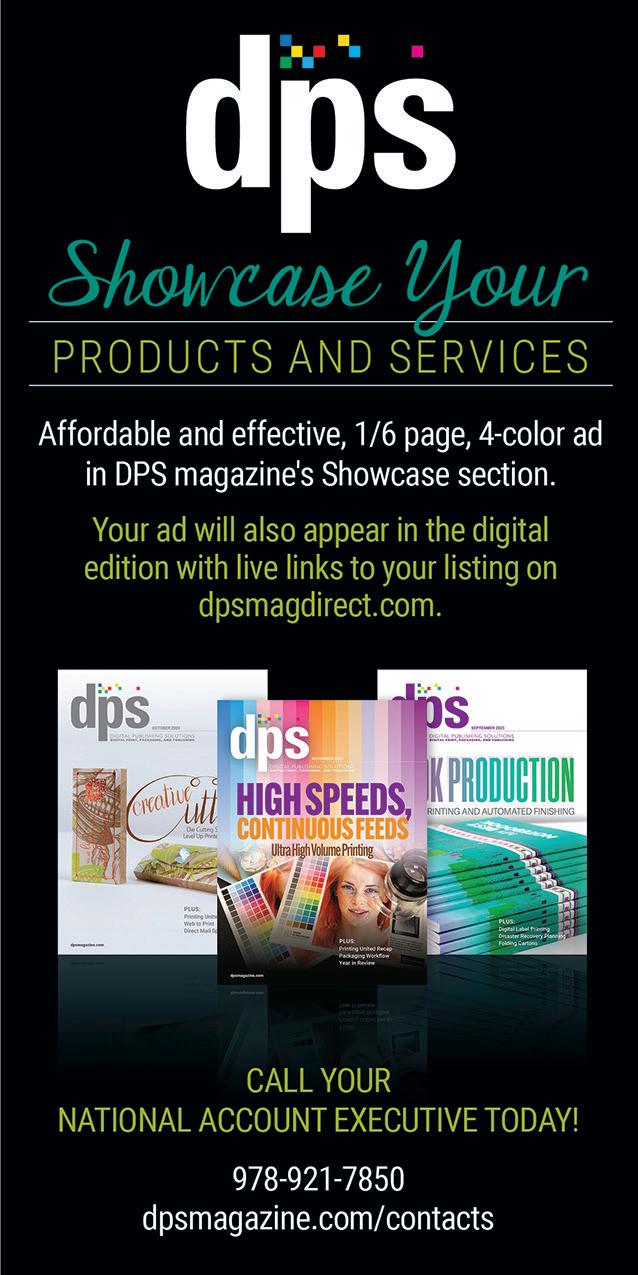
1Canon Solutions America 2pps.csa.canon.com
3Duplo U.S.A. Corp. 27duplousa.com
9Esko | Enfocus 10esko.com / enfocus.com
15General Formulations 19generalformulations.com
4Graphic Whizard Inc. 25graphicwhizard.com
6Komori America 9komori-america.us
5Labelexpo Americas 15labelexpo.com
7MBO | Komori Group 21mboamerica.com
8Muller Martini 5mullermartini.com
2PressWise by SmartSoft 12presswise.com
13Shark Finishing Machinery26sharkmachinery.com
10Sharp Electronics Corp. 23sharpusa.com
11Signs365 28signs365.com
12Therm-O-Type 15thermotype.com
14Valloy Inc. 26valloy.com

